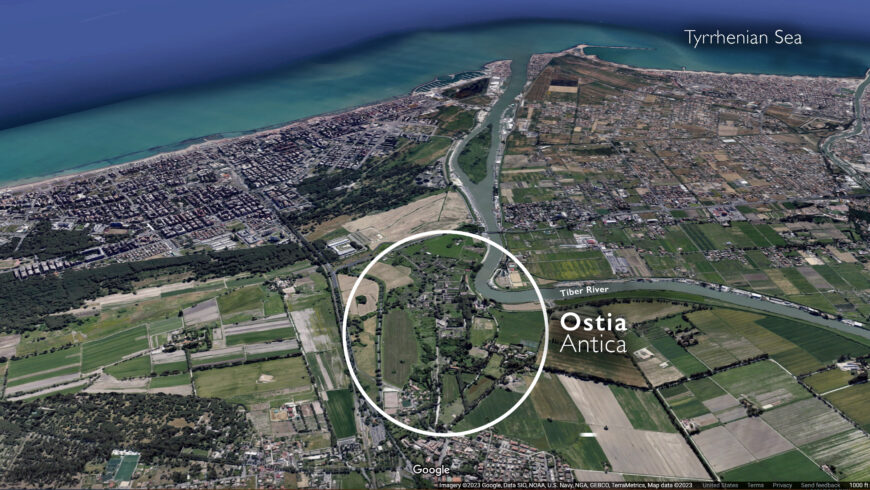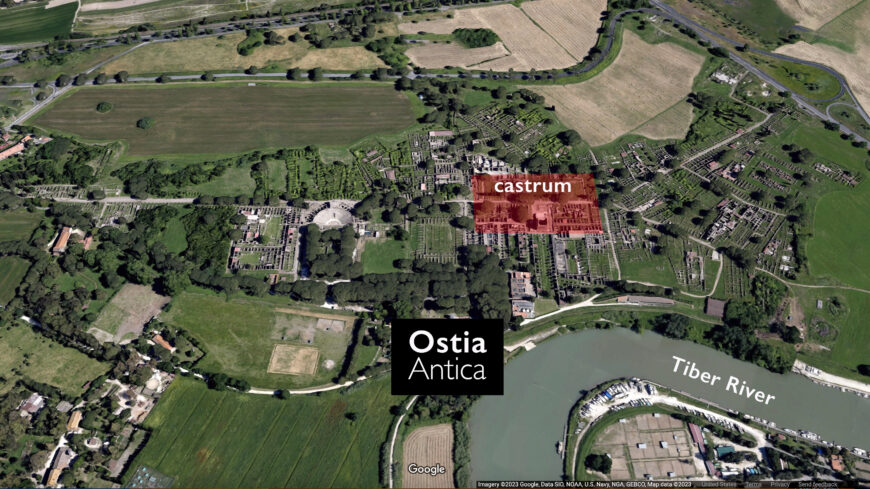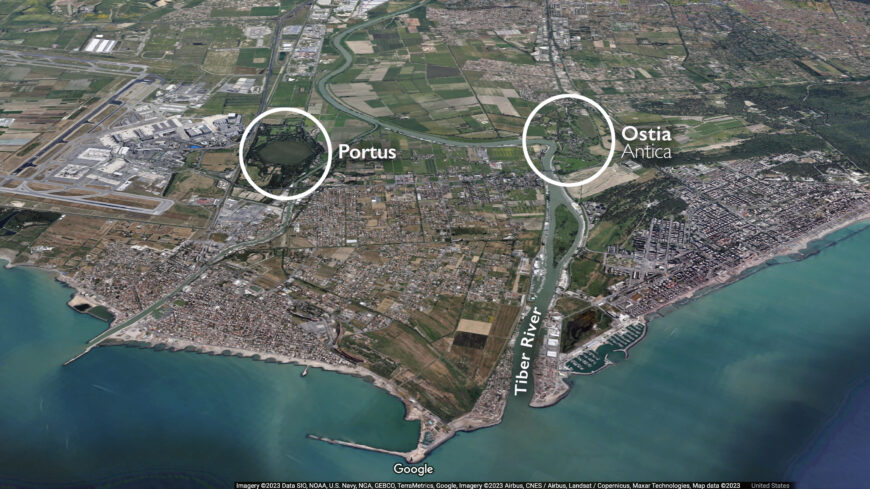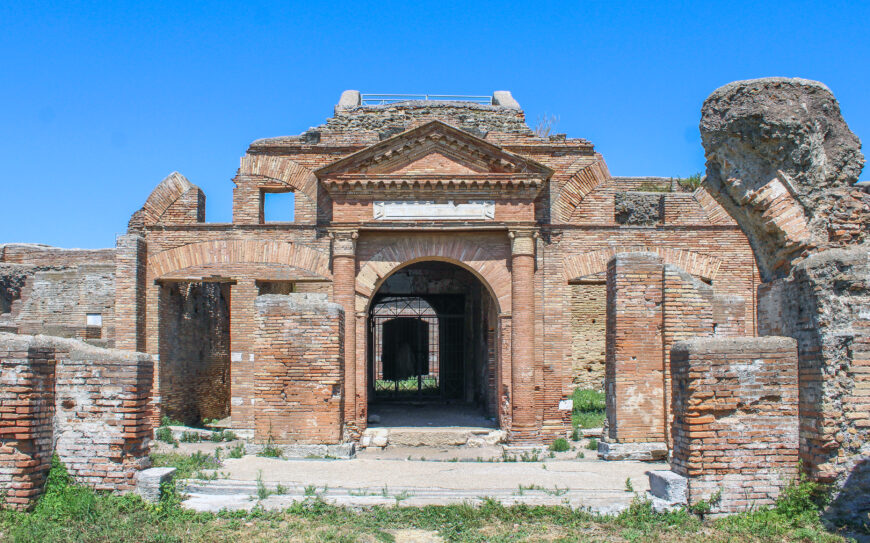The ancient Roman city of Ostia was a diverse, working class city with inhabitants from across the Mediterranean world.
Origins
Although the Roman state would eventually grow to be a large empire, it began humbly as a small village on the Palatine Hill in Rome in the 8th century B.C.E. As the city grew, so did the desire to help protect itself from enemies who might try to access it from the sea. This led to the establishment of Rome’s first colony, Ostia. Ostia is located approximately 15 miles west of Rome where the Tiber River drains into the Tyrrhenian Sea. Today, Ostia is located further inland as the landscape has expanded over the past two millennia.
According to ancient tradition, Ostia was founded in the 7th century B.C.E during the reign of king Ancus Marcius during Rome’s monarchic period, but the earliest archaeological evidence recorded only dates to the 4th century B.C.E. The earliest known remains of the city show that it was laid out as a castrum (a Roman military camp divided into four quadrants by north-south and east-west roads and surrounded by a defensive wall).
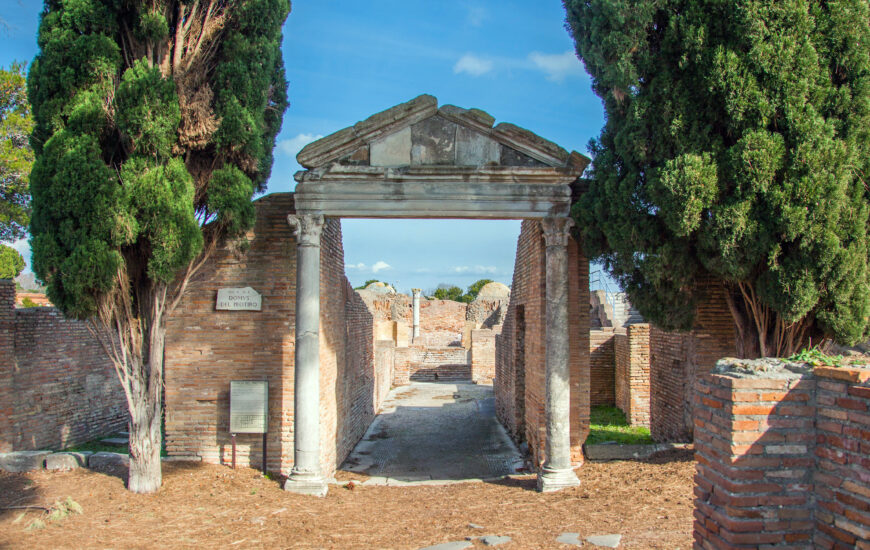
House of the Porch, Ostia Antica (photo: Bradley Weber, CC BY 2.0)
Growth
The city of Rome originally featured a small port along the Tiber River in the area of what later became the Forum Boarium, or cattle market. As the city grew, so did the need for a larger port, and Ostia was the perfect location. Though Ostia did not reach its peak size and prosperity until the 2nd century C.E., the city experienced its first notable expansion in the early 1st century B.C.E. thanks to the Roman general Sulla, who also built a new, much larger wall around the city to protect its expanding territory. While the city continued to grow for centuries after its establishment, the center of the city grid continued to follow the castrum plan even as the other streets and buildings grew up around it.
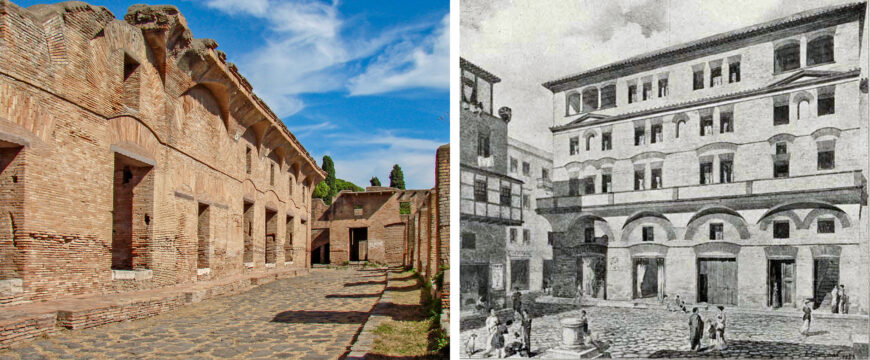
Insulae in Ostia. Left: House of Diana, Ostia Antica (photo: Jean-Pierre Dalbéra, CC BY 2.0); right: speculative reconstruction, House of Diana by Italo Gismondi
As Rome’s port city, the population of Ostia included both permanent residents as well as temporary residents like merchants who came to trade from across the Mediterranean. Most of Ostia’s population was comprised of the working class, the majority of which lived in insulae, or apartment buildings.
Forum and Capitolium
Like other Roman cities, the forum was the center of both political and civic life. Though Ostia had existed for centuries, the forum did not begin to develop as a civic center until the 1st century B.C.E. Just as in the Forum Romanum in Rome, the forum at Ostia featured a basilica (judicial court), a curia (Senate House), temples, and a large open space in the center. To the south of the forum was the Temple of Roma (the personification of the city of Rome) and Augustus.
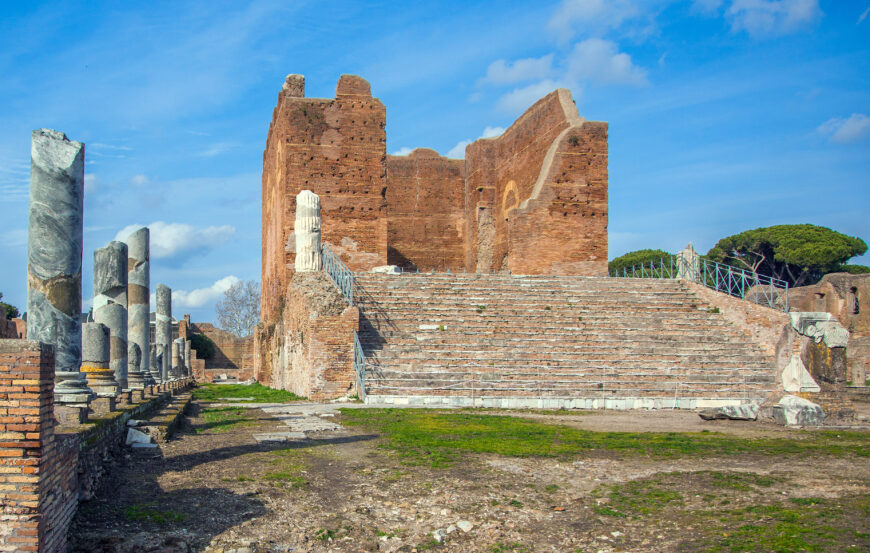
Capitolium in the forum, c. 117–138 C.E., Ostia Antica (photo: Bradley Weber, CC BY 2.0)
To the north was the Capitolium, a temple dedicated to the worship of three deities: Jupiter, Juno, and Minerva, known as the Capitoline Triad. The remains of the Capitolium date to the emperor Hadrian’s reign, though it likely replaced an earlier temple or shrine.
As is typical of many Roman temples, it featured a high podium, a single frontal staircase leading to a deep porch, and Corinthian columns topped with a pediment. The temple was hexastyle, meaning that there were 6 columns across the façade. Unlike the Temple of Jupiter Optimus Maximus on the Capitoline Hill in Rome, this temple did not have three cellae (cult rooms). Instead, it had one cella with space for three cult statues.
The temple was constructed of concrete faced with Roman bricks (opus latericium), which are typically longer and thinner than modern bricks. However, this brick-faced concrete core would not have been visible in antiquity as the temple was originally faced with white marble. The interior floor of the cella was covered with opus sectile, colorful cut marbles arranged into geometric patterns.
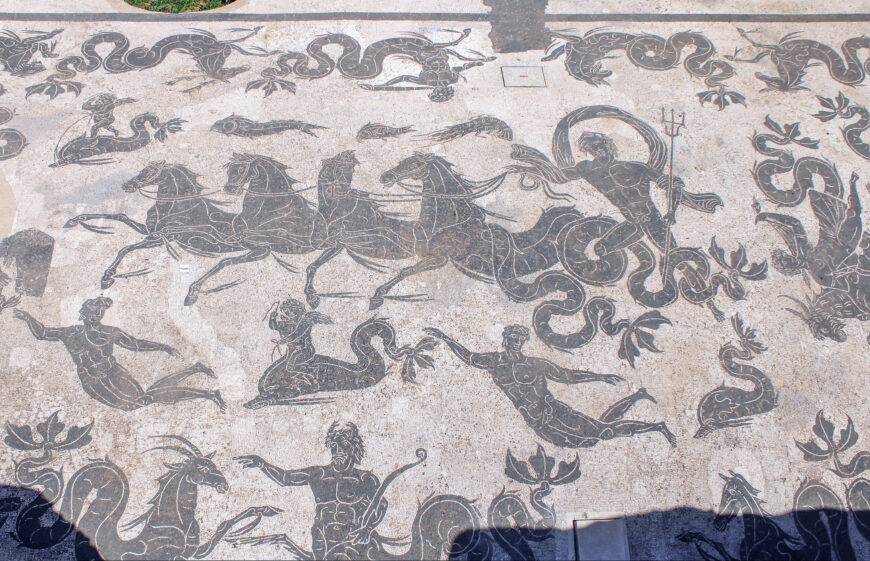
Mosaic with Neptune holding a trident riding a quadriga, Baths of Neptune, Ostia (photo: Jessica Mingoia, all rights reserved)
The baths
To date, excavations in Ostia have uncovered 26 bath complexes. Though none of them are imperial baths on the scale of those in Rome, like the Baths of Caracalla, bathing was a central part of Roman life in any location. Most of the bath complexes featured the typical changing room (apodyterium), hot baths (caldarium), warm baths (tepidarium), and cold baths (frigidarium), but only the larger structures had room for a palaestra (open-air exercise area).
One of the bath complexes is the so-called Baths of Neptune constructed in the 2nd century C.E. The baths received their modern name thanks to a mosaic of Neptune, the god of the sea, surrounded by sea creatures and mythological beings. In the center, Neptune rides on a quadriga (a chariot led by four hippocamps, which are half horse, half sea creature). He is surrounded by sea nymphs, Tritons (sea-gods), dolphins, and other real and mythological sea creatures.
Like the majority of mosaics in Ostia, it was made of only black and white tesserae. Black and white mosaics were less expensive than mosaics with colorful tesserae, but even opulent buildings feature black and white mosaics, suggesting that it reflects a shift in aesthetic preferences rather than cost. The background is white with no sense of depth. The figures appear as silhouettes in black tesserae, though white tesserae are used to provide outlines to the muscles, drapery, and hair.
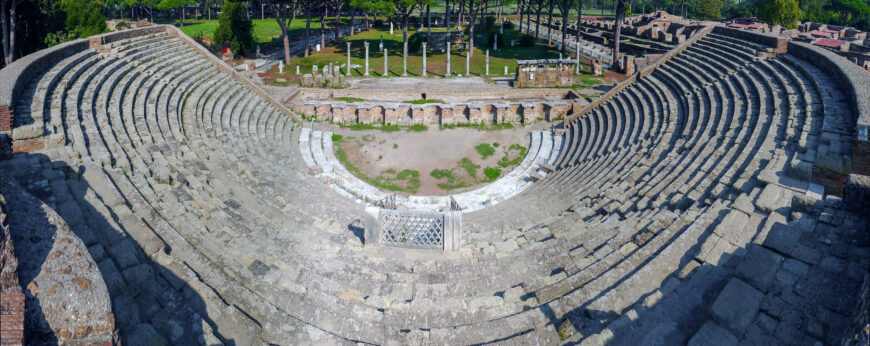
Theatre and the Piazzale delle Corporazioni in the distance, Ostia (photo: Groume, CC BY-SA 2.0)
Theatre & Piazza of the Corporations
Not far from the forum was a theatre. Unlike Greek theatres, which are typically constructed on top of a natural hillside, Roman theatres were free-standing. Though it was originally constructed in the 1st century B.C.E., it was renovated and expanded in the late 2nd century C.E. As was typical of Roman theatres, it was shaped like a half-circle.
The cavea, or tiered seating area, held approximately 3,000 spectators and was supported by a series of concrete barrel vaults. The cavea could be accessed through a barrel-vaulted tunnel in the center of the exterior façade, four staircases leading to the higher seating areas, or a corridor located on each side of the theatre between the cavea and stage.
Like many structures in Ostia, the façade was faced in Roman bricks. Unlike the Capitolium, the brick was left exposed. Inside the theatre, the area located in front of the cavea is known as an orchestra, an open space in the shape of another half-circle. The orchestra space was used by the actors, as was the pulpitum, the elevated, flat, rectangular space bordering the straight side of the orchestra which resembles our modern stages. Behind the pulpitum was the scaenae frons, a large architectural façade that forms the back wall of the stage.
Typically, the scaenae frons of a theatre was two to three stories in height and equal to the height of the top of the cavea. It featured a façade with architectural projections and recessions, marble columns and sculpture. Unfortunately, the scaenae frons did not survive to the present, though the theatre is occasionally still used today for theatrical and musical performances.
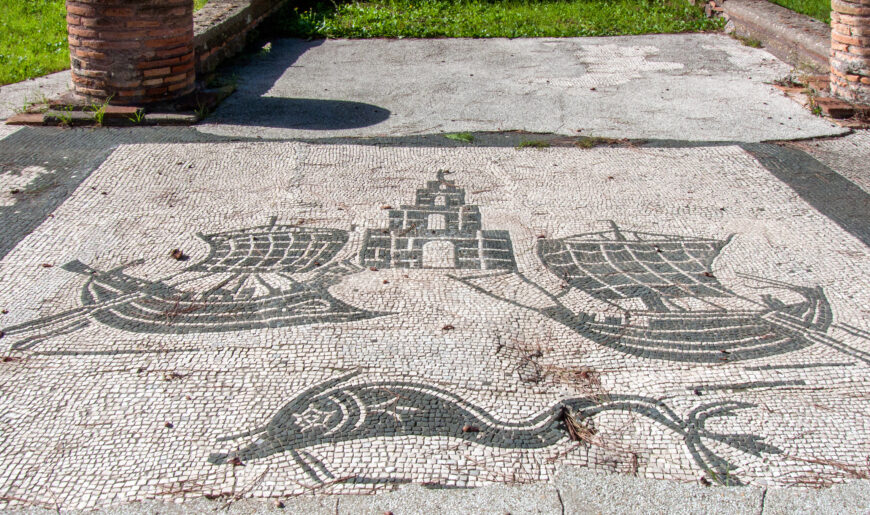
Office mosaic with lighthouse, ships, and dolphin, Piazzale delle Corporazioni, Ostia (photo: Mr. Allan Parsons, CC BY 2.0)
Behind the scaenae frons was a double-rowed portico divided in the center by a colonnade which was constructed under the Emperor Hadrian. Under the Emperor Commodus, one row of the portico was converted into 61 small rooms which functioned as offices for the merchants, shippers, and traders who conducted business out of Ostia. Today, this is called the Piazzale delle Corporazioni, or Piazza of the Corporations.
Each of these offices featured a black and white floor mosaic which helped to identify the business conducted within. Many of the mosaics depict ships, a fitting subject for a city that served as the port of Rome and a major trade hub. One mosaic even portrays an elephant which suggests the merchant or trader who operated from this office imported elephants from North Africa for Roman gladiatorial spectacles.
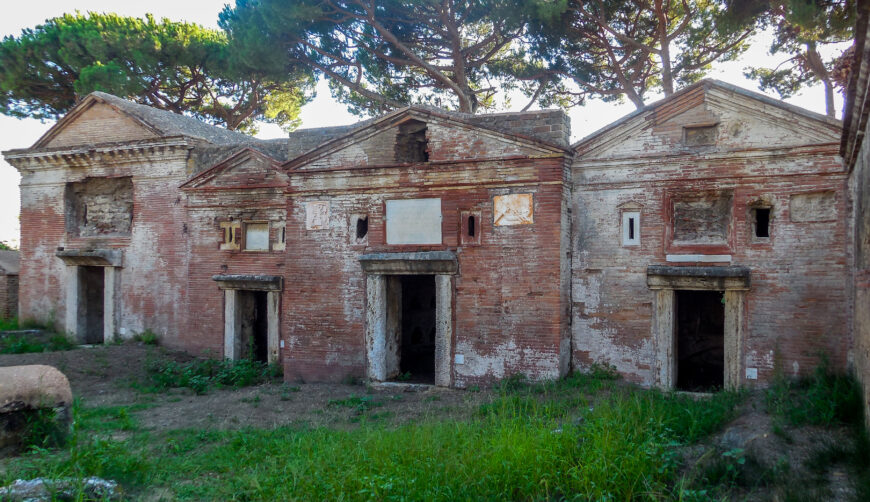
Necropolis, Isola Sacra, north of Ostia (photo: isafmt, CC BY 2.0)
Isola Sacra
North of the city was the Isola Sacra, a necropolis on its own island located between the two branches of the Tiber where the river spilled into the sea. Isola Sacra, or Sacred Island, is a modern name. The necropolis contains more than 100 tombs which resemble small, brick-faced houses.
Many of the deceased in these tombs are freedmen (formerly enslaved people) and Ostia’s working class. The exterior of these tombs often feature terracotta relief plaques that reference the deceased’s occupation such as grain mills, ships, vegetable vendors, and midwifes. These plaques are indicative of the pride shown by the merchant class in their professions.
The ports
The port of Ostia was located to the north of the Isola Sacra at Portus, above the upper branch of the Tiber River. The Emperor Claudius constructed a harbor and channel beginning in 42 C.E. It included a small island with a lighthouse at the harbor entrance to help guide ships into port. However, it was the construction of Emperor Trajan’s hexagonally shaped artificial harbor basin that helped bring great prosperity to the city, leading to the construction and population boom of the 2nd century C.E. The port included mooring for 100 ships simultaneously.
The port and the buildings which surrounded it are known as Portus. Portus featured many warehouses to accommodate the large influx of goods imported and exported and eventually became its own micro-city with a bath complex, temples, and apartments, serving as an extension of Ostia. Though today Portus is no longer located on the edge of the sea, the hexagonal basin is still visible in the Italian landscape.
Warehouses
Once goods were unloaded from the ships, they were stored in warehouses. Items temporarily stored at Portus would then be moved by barges to either Ostia or Rome to be stored in other warehouses and then distributed to other locations if needed. These warehouses were known as horrea.
The most well-known warehouse in Ostia is the Horrea Epagathiana & Epaphroditiana, constructed during the reign of Emperor Antoninus Pius. It, too, featured brick-faced concrete. Even the “columns” at the entrance portal and pediment above are constructed of brick, exhibiting a new 2nd century C.E. style where brick is appreciated for its own aesthetic value. Bricks were even shaped into volutes (scrolls) at the top of the column capitals, eliminating the need for carved stone.
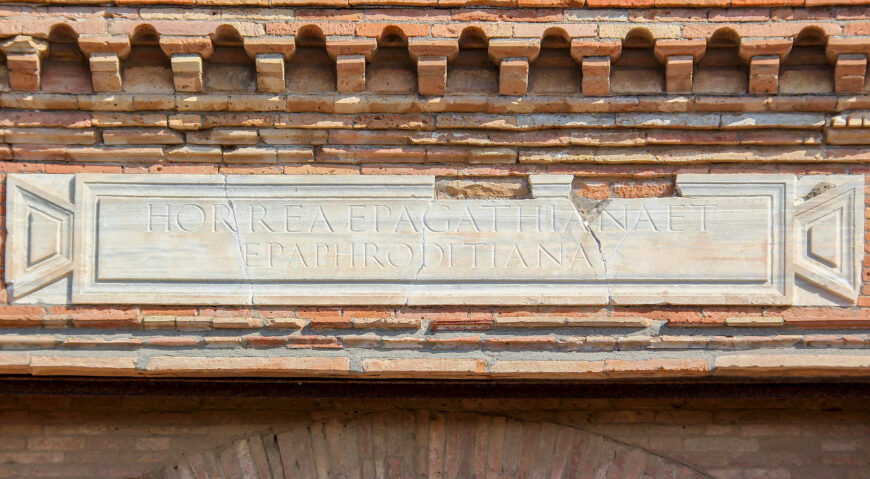
Sign, Horrea Epagathiana & Epaphroditiana (photo: Klaus Heese, all rights reserved)
A marble inscription on the façade identifies the owners as Epagathiana and Epaphroditiana, two freedmen. Their warehouse held grain, one of the main trade commodities at this time. The façade featured a row of shops and the interior contained many storage rooms, a courtyard, an office, and two staircases leading to an upper story. While this is the best-preserved example, numerous warehouses could be found around Ostia and Portus.
Decline
Despite once being a major trade hub and thriving city with a population of as many as 100,000 people, Ostia declined in population and prosperity starting in the 400s and 500s C.E. when power shifted out of the city of Rome and to Constantinople in the east. The city was fully abandoned in the 9th century due to pirate attacks and a rise of malaria from mosquitoes found in the marshy areas of the river bordering the city.
Archaeological excavations have been ongoing since the 1930s, though less than one-third of the city has been unearthed. Today, the site functions as an open-air museum.
Additional resources
Ostia: Harbour City of Ancient Rome
Gregory S. Aldrete, Daily Life in the Roman City: Rome, Pompeii, and Ostia (Norman: University of Oklahoma Press, 2004).
Guido Calza, Ostia: Historical Guide to the Monuments (Milan: Bestetti e Tummimelli, 1926).
Guido Calza, Scavi di Ostia, 1: Topografia Generale (Rome: Libreria dello Stato, 1953).
Filippo Coarelli, Ostia repubblicana (Rome: Edizioni Quasar, 2021).
Janet DeLaine, “The Commercial Landscape of Ostia,” Roman Working Lives and Urban Living, edited by Ardle Mac Mahon and Jennifer Price (Oxford: Oxbow Books: 2005), pp. 29–47.
Gustav Hermansen, Ostia: Aspects of Roman Life (Edmonton: University of Alberta Press, 1982).
Arja Karivieri, editor, Life and Death in a Multicultural Harbour City: Ostia Antica from the Republic through Late Antiquity (Acta Instituti Romani Finlandiae, volume 47) (Rome: Institutum Romanum Finlandiae, 2020).
Simon Keay et al., editors, The Isola Sacra Survey: Ostia, Portus and the port system of Imperial Rome (Cambridge, U.K.: McDonald Institute for Archaeological Research, 2020).
Fred S. Kleiner, “Ostia: Port and Mirror of Rome,” A History of Roman Art, 2nd edition (Boston: Cengage Learning, 2018), pp. 235–47.
Russel Meiggs, Roman Ostia, 2nd edition (Oxford: Clarendon Press, 1973).
James E. Packer, The Insulae of Imperial Ostia (Memoirs of the American Academy in Rome, volume 31) (Rome: The American Academy in Rome, 1971).
Carlo Pavolini, Ostia (Bari: Laterza, 2006).

